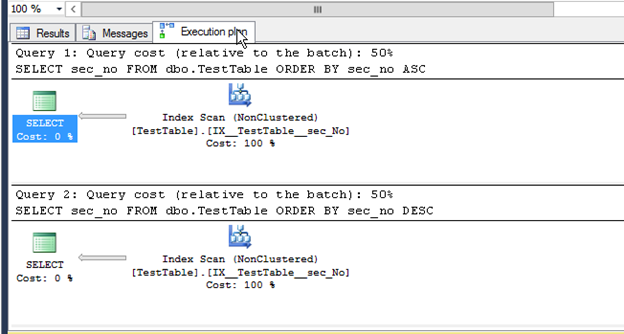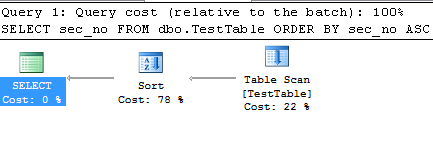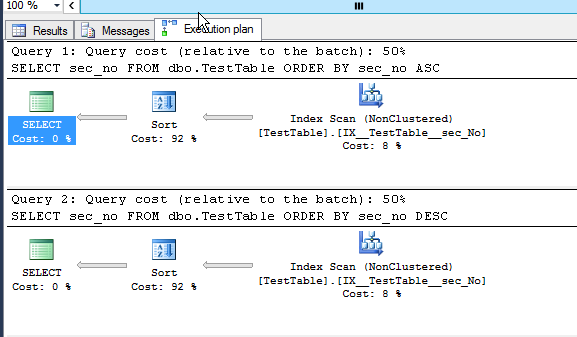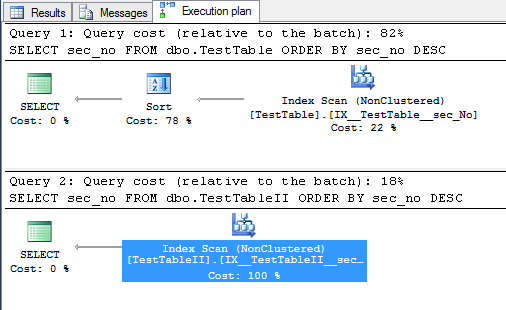I need to cover few scenarios connected to SQL statements or procedures and their Execution plans and IO statistics:
- To monitor stored procedures performance running on server
-
To get execution plan from procedures not easily accessible from management studio
- Procedures called from service broker applications
- Huge nested level of SQL statement
- Compare batches in testing labs
I decided to use Extended Events as lightweight solution for such a scenarios.
I found following tree evens very usefull to get requested data.
-
sqlserver.query_post_execution_showplan
- to get execution plan of running query
-
sqlserver.sql_statement_completed
- to get IO informations regarding executed query
-
sqlserver.sp_statement_completed
- to get IO informations regarding executed stored procedure¨
Bellow you can find simple script creating above mentioned events with resctriction to concreted session and database.
CREATE EVENT SESSION Test ON SERVER
ADD EVENT sqlserver.query_post_execution_showplan -- ,
(
ACTION (sqlserver.database_name,
sqlserver.plan_handle,
sqlserver.query_plan_hash,
sqlserver.session_id,
sqlserver.sql_text,
sqlserver.username)
WHERE
sqlserver.session_id=58
AND sqlserver.database_id = 8
)
,
ADD EVENT sqlserver.sql_statement_completed -- ,
(
ACTION (sqlserver.database_name,
sqlserver.plan_handle,
sqlserver.query_plan_hash,
sqlserver.session_id,
sqlserver.sql_text,
sqlserver.username)
WHERE
sqlserver.session_id=58
AND sqlserver.database_id = 8
),
ADD EVENT sqlserver.sp_statement_completed -- ,
(
ACTION (sqlserver.database_name,
sqlserver.plan_handle,
sqlserver.query_plan_hash,
sqlserver.session_id,
sqlserver.sql_text,
sqlserver.username)
WHERE
sqlserver.session_id=58
AND sqlserver.database_id = 8
)
ADD TARGET package0.ring_buffer (SET max_memory = 4096 ) WITH (max_dispatch_latency = 1 seconds)
Let’s start the session.
ALTER EVENT SESSION Test ON SERVER STATE = START
Here is an example to get data from the session.
SELECT CAST(LocksAcquired.TargetXml AS XML) AS XMLData
INTO #LogData
FROM (SELECT CAST(t.target_data AS XML) AS TargetXml
FROM sys.dm_xe_session_targets AS t
JOIN sys.dm_xe_sessions AS s ON s.address= t.event_session_address
WHERE s.name= 'Test' ) AS LocksAcquired;
SELECT T.XMLData.value('(action[@name="sql_text"])[1]','varchar(1000)' ) AS [SqlText],
T.XMLData.value('(@timestamp)[1]', 'datetime' ) AS [OccurredDtTm],
T.XMLData.value('(data[@name="message"])[1]','varchar(60)') AS [Message]
,T.XMLData.value('(action[@name="username"])[1]','SYSNAME') AS [UserName]
,T.XMLData.value('(action[@name="session_id"])[1]','INT') AS [SessionID]
,T.XMLData.value('(action[@name="query_plan_hash"])[1]','DECIMAL(38,0)') AS [QueryPLanHash]
,T.XMLData.value('(action[@name="plan_handle"])[1]','VARBINARY(MAX)') AS [QueryPLanHandle]
,T.XMLData.value('(data[@name="cpu_time"])[1]','INT') AS [CPUTime]
,T.XMLData.value('(data[@name="duration"])[1]','BIGINT') AS [Duration]
,NULL [PhysicalReads]
,NULL [LogicalReads]
,NULL [Writes]
,NULL [RowCount]
,T.XMLData.value('(data[@name="object_type"])[1]','SYSNAME') AS [ObjectType]
,T.XMLData.value('(data[@name="object_id"])[1]','INT') AS [ObjectID]
,U.XMLData.query('.') AS [XML]
,T.XMLData.value('(data[@name="estimated_rows"])[1]','BIGINT') AS [EstimatedRow]
,T.XMLData.value('(data[@name="estimated_cost"])[1]','BIGINT') AS [EstimatedCost]
, 'QueryPlan' AS [type]
INTO #finalset
FROM #LogData x
CROSS APPLY x.XMLData.nodes('/RingBufferTarget/event[@name="query_post_execution_showplan"]') AS T(XMLData)
CROSS APPLY t.XMLData.nodes('data[@name="showplan_xml"]/value/*') AS U(XMLData);
SELECT T.XMLData.value('(action[@name="sql_text"])[1]','varchar(1000)') AS [SqlText],
T.XMLData.value('(@timestamp)[1]', 'datetime') AS [OccurredDtTm],
T.XMLData.value('(data[@name="message"])[1]','varchar(60)') AS [Message]
,T.XMLData.value('(action[@name="username"])[1]','SYSNAME') AS [UserName]
,T.XMLData.value('(action[@name="session_id"])[1]','INT') AS [SessionID]
,T.XMLData.value('(action[@name="query_plan_hash"])[1]', 'DECIMAL(38,0)' ) AS [QueryPLanHash]
,T.XMLData.value('(action[@name="plan_handle"])[1]', 'VARBINARY(MAX)' ) AS [QueryPLanHandle]
,T.XMLData.value('(data[@name="cpu_time"])[1]', 'INT') AS [CPUTime]
,T.XMLData.value('(data[@name="duration"])[1]','BIGINT') AS [Duration]
,T.XMLData.value('(data[@name="physical_reads"])[1]','BIGINT') [PhysicalReads]
,T.XMLData.value('(data[@name="logical_reads"])[1]','BIGINT') [LogicalReads]
,T.XMLData.value('(data[@name="writes"])[1]', 'BIGINT' ) [Writes]
,T.XMLData.value('(data[@name="row_count"])[1]','BIGINT') [RowCount]
,T.XMLData.value('(data[@name="object_type"])[1]', 'SYSNAME' ) AS [ObjectType]
,T.XMLData.value('(data[@name="object_id"])[1]', 'INT' ) AS [ObjectID]
-- ,U.XMLData.query('.') AS [XML]
,CAST (NULL AS XML) AS [XML]
,T.XMLData.value('(data[@name="estimated_rows"])[1]','BIGINT') AS [EstimatedRow]
,T.XMLData.value('(data[@name="estimated_cost"])[1]','BIGINT') AS [EstimatedCost]
, 'IOSql' AS [type]
INTO #finalsetII
FROM #LogData x
CROSS APPLY x.XMLData.nodes('/RingBufferTarget/event[@name="sql_statement_completed"]') AS T(XMLData)
SELECT T.XMLData.value('(action[@name="sql_text"])[1]','varchar(1000)') AS [SqlText],
T.XMLData.value('(@timestamp)[1]', 'datetime' ) AS [OccurredDtTm],
T.XMLData.value('(data[@name="message"])[1]','varchar(60)' ) AS [Message]
,T.XMLData.value('(action[@name="username"])[1]', 'SYSNAME') AS [UserName]
,T.XMLData.value('(action[@name="session_id"])[1]','INT' ) AS [SessionID]
,T.XMLData.value('(action[@name="query_plan_hash"])[1]','DECIMAL(38,0)') AS [QueryPLanHash]
,T.XMLData.value('(action[@name="plan_handle"])[1]','VARBINARY(MAX)' ) AS [QueryPLanHandle]
,T.XMLData.value('(data[@name="cpu_time"])[1]','INT') AS [CPUTime]
,T.XMLData.value('(data[@name="duration"])[1]','BIGINT') AS [Duration]
,T.XMLData.value('(data[@name="physical_reads"])[1]', 'BIGINT' ) [PhysicalReads]
,T.XMLData.value('(data[@name="logical_reads"])[1]', 'BIGINT' ) [LogicalReads]
,T.XMLData.value('(data[@name="writes"])[1]', 'BIGINT' ) [Writes]
,T.XMLData.value('(data[@name="row_count"])[1]', 'BIGINT' ) [RowCount]
,T.XMLData.value('(data[@name="object_type"])[1]','SYSNAME') AS [ObjectType]
,T.XMLData.value('(data[@name="object_id"])[1]', 'INT' ) AS [ObjectID]
-- ,U.XMLData.query('.') AS [XML]
, CAST(NULL AS XML) AS [XML]
,T.XMLData.value('(data[@name="estimated_rows"])[1]','BIGINT')AS [EstimatedRow]
,T.XMLData.value('(data[@name="estimated_cost"])[1]', 'BIGINT' ) AS [EstimatedCost]
, 'IOProcedure' AS [type]
INTO #finalsetIII
FROM #LogData x
CROSS APPLY x.XMLData.nodes('/RingBufferTarget/event[@name="sp_statement_completed"]') AS T(XMLData)
--CROSS APPLY t.XMLData.nodes('data[@name="showplan_xml"]/value/*') AS U(XMLData)
;
SELECT * FROM #finalset UNION ALL SELECT * FROM #finalsetII UNION ALL SELECT * FROM #finalsetIII
Do not forget to clear your session
IF EXISTS (SELECT * FROM sys.server_event_sessions WHERE name = 'Test') BEGIN DROP EVENT SESSION Test ON SERVER; END
In next post I will publish SQL routines in which above mentioned script will be encapsulated.








